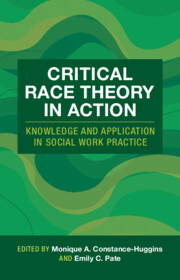Refine search
Actions for selected content:
309 results
36 - Between Identity and Form
-
-
- Book:
- The Cambridge History of Australian Poetry
- Published online:
- 19 November 2025
- Print publication:
- 11 December 2025, pp 670-691
-
- Chapter
- Export citation

Justice, Equity, Diversity, and Inclusion in the United States
-
- Published online:
- 19 November 2025
- Print publication:
- 30 October 2025
-
- Textbook
-
- You have access
- Open access
- Export citation

Lauren Gunderson and Feminist Theatre in the Twenty-First Century
-
- Published online:
- 17 November 2025
- Print publication:
- 11 December 2025
-
- Element
-
- You have access
- HTML
- Export citation
Case 3.3 - Making Visible the Invisible
- from Part III - Case Studies in Mezzo-Level Practice
-
-
- Book:
- Critical Race Theory in Action
- Published online:
- 25 October 2025
- Print publication:
- 13 November 2025, pp 81-96
-
- Chapter
- Export citation
Case 2.3 - Adversity at the Crossroads
- from Part II - Case Studies in Micro-Level Practice
-
-
- Book:
- Critical Race Theory in Action
- Published online:
- 25 October 2025
- Print publication:
- 13 November 2025, pp 40-51
-
- Chapter
- Export citation
Always Gender but Not Only Gender: Operationalizing Intersectionality in Swedish Gender Equality Policy
-
- Journal:
- Politics & Gender , First View
- Published online by Cambridge University Press:
- 12 November 2025, pp. 1-26
-
- Article
-
- You have access
- Open access
- HTML
- Export citation
Paternalistic Push & Pull: The Role of Sexism in Public Opinion of Kamala Harris
-
- Journal:
- Journal of Race, Ethnicity and Politics , First View
- Published online by Cambridge University Press:
- 10 November 2025, pp. 1-23
-
- Article
-
- You have access
- Open access
- HTML
- Export citation
14 - Non-discrimination and Equality
-
- Book:
- Human Rights Law in the UK
- Published online:
- 11 November 2025
- Print publication:
- 30 October 2025, pp 764-859
-
- Chapter
- Export citation
5 - Why Are Black Mothers Dying?
- from Part II - Learning from Women of Color
-
- Book:
- Justice, Equity, Diversity, and Inclusion in the United States
- Published online:
- 19 November 2025
- Print publication:
- 30 October 2025, pp 101-124
-
- Chapter
-
- You have access
- Open access
- HTML
- Export citation
Virtual reality offerings for wellbeing for and by marginalized populations: A scoping review on equity and intersectionality
-
- Journal:
- Cambridge Prisms: Global Mental Health / Volume 12 / 2025
- Published online by Cambridge University Press:
- 29 October 2025, e131
-
- Article
-
- You have access
- Open access
- HTML
- Export citation
Priority setting for health equality – searching for an ethical framework
-
- Journal:
- Health Economics, Policy and Law , First View
- Published online by Cambridge University Press:
- 27 October 2025, pp. 1-14
-
- Article
-
- You have access
- Open access
- HTML
- Export citation

Critical Race Theory in Action
- Knowledge and Application in Social Work Practice
-
- Published online:
- 25 October 2025
- Print publication:
- 13 November 2025
Climate-related vulnerabilities and the European Court of Human Rights: Reimagining victim status through intersectional thinking
-
- Journal:
- Leiden Journal of International Law , First View
- Published online by Cambridge University Press:
- 15 October 2025, pp. 1-24
-
- Article
-
- You have access
- Open access
- HTML
- Export citation
Gendered Rhythms in the Urbs: An Intersectional and Temporospatial Analysis of Female Visibility during Religious Activity in Urban Spaces in Republican Rome
-
- Journal:
- Antichthon , First View
- Published online by Cambridge University Press:
- 14 October 2025, pp. 1-28
-
- Article
- Export citation
Navigating Everyday Otherness: Multicultural Experiences of Indonesian Migrant Women in South Korea
-
- Journal:
- TRaNS: Trans-Regional and -National Studies of Southeast Asia , First View
- Published online by Cambridge University Press:
- 07 October 2025, pp. 1-14
-
- Article
- Export citation
The Political Implications of Identifying as a “Woman of Color” for Latina and Asian American Women
-
- Journal:
- Journal of Race, Ethnicity and Politics , First View
- Published online by Cambridge University Press:
- 06 October 2025, pp. 1-30
-
- Article
-
- You have access
- Open access
- HTML
- Export citation
Chapter 5 - Stand-Up Comedy and Gender
- from Part II - Interpretation and Meaning
-
-
- Book:
- The Cambridge Companion to Stand-Up Comedy
- Published online:
- 21 August 2025
- Print publication:
- 04 September 2025, pp 107-123
-
- Chapter
- Export citation
Chapter 11 - Stand-Up and Politics
- from Part II - Interpretation and Meaning
-
-
- Book:
- The Cambridge Companion to Stand-Up Comedy
- Published online:
- 21 August 2025
- Print publication:
- 04 September 2025, pp 206-221
-
- Chapter
- Export citation
Equality Law: A Structural Turn
-
- Journal:
- German Law Journal / Volume 26 / Issue 2 / March 2025
- Published online by Cambridge University Press:
- 01 September 2025, pp. 153-169
-
- Article
-
- You have access
- Open access
- HTML
- Export citation
10 - Gender Politics
-
-
- Book:
- The Cambridge Companion to James Joyce
- Published online:
- 14 August 2025
- Print publication:
- 21 August 2025, pp 169-183
-
- Chapter
- Export citation
